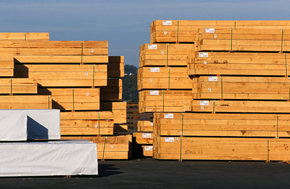George Hoberg and Gabrielle Schittecatte
October 10, 2015
Since before Confederation, trade in lumber between Canada and the United States has been politically contentious. The modern conflict began in 1982, when the US softwood industry asked the US government to impose countervailing duties on imports from Canada. As Canada’s largest lumber producer, British Columbia has been strongly affected by US trade actions.
US lumber interests argue that Canadian policies have the effect of subsidizing lumber exports to the US, giving Canadian lumber an unfair advantage and making them inconsistent with the US Trade Act and free trade agreements. The biggest source of concern has been how stumpage (the price paid by a forest company for what is a publically owned tree) is set in the country. In most of the US, where private forest land dominates, trees are priced by markets. Because of the public land model north of the border, stumpage in Canada, including BC, is set administratively. The US has long argued that the way stumpage is calculated amounts to an unfair subsidy. The US has also complained about direct subsidies to the forest sector, limitations on log exports, and cut control policies.
In the early 1980s the US lumber industry petitioned the US Department of Commerce (DoC) to implement its countervailing duties, a tax the US would then charge Canada on its softwood exports. The DoC declined to do so. In 1986 the US lumber industry again petitioned the DoC to establish countervailing duties, which it agreed to at a level of 15%. However, before this could take place Canada agreed to a Memorandum of Understanding (MOU) which established a phased export tariff. In essence, Canada, in order to decrease tensions on the matter, agreed to tax itself so at least revenues would remain within the country.
In 1991 Canada withdrew from the MOU and the US industry petitioned the DoC again to implement countervailing duties, which it did at a level of 6.5%. This decision was reviewed under the Canadian-US Free Trade Agreement (a predecessor of NAFTA). The review panel ruled in Canada’s favour, finding that the DoC had not made a convincing case under the US Trade Act. Consequently, Congress amended the Trade Act to make it easier to demonstrate the existence of an illegal subsidy. In response, Canada agreed to the 1996 Softwood Lumber Agreement, which was planned to last five years. This agreement determined that a certain amount of softwood exports would be allowed tax free, but that above this level there would be substantial export fees.
In 2001 the Softwood Lumber Agreement expired, and the US forest industry again applied for countervailing duties. This time, the DoC agreed to impose even higher duties, at 27.2%. Canada again challenged the decision under the dispute settlement mechanisms of both NAFTA and the World Trade Organization (WTO), virtually all of which ruled in Canada’s favour.
At the same time, the BC government embarked on an extensive policy reform designed in part to address US criticisms by substantially increasing the role of market forces in determining stumpage and other aspects of BC forest policy. The 2003 Forest Revitalization Plan included a 20% take back of harvesting rights, half of which were allocated to auctions to create a system of market-based pricing. Appurtenancy was eliminated, along with other reforms to “bring the market back in.” One key part of the justification for these changes was to address the concerns raised by the US in the softwood lumber dispute.
Despite BC’s significant policy reforms, and the victories in dispute settlement mechanisms, Canada agreed again, in 2006, to enter into an agreement where export taxes were collected if the price of lumber fell below a particular threshold. The US refused to return the $5 billion in duties inappropriately collected from the industry over the past 4 years, and Canada felt the need to agree to trade restraints to get access to the funds. The 2006 Softwood Lumber Agreement, which would last for 7 years and be renewed for 2 more, places an export charge on lumber based on the current market price measured in price per thousand board feet. The charges on lumber increase when the market price of lumber decreases – the maximum rate is 15% if the price falls below $315, and goes to zero if the price exceeds $355. In September 2015, Canadian exporters paid a tax of $5 US because the price of lumber was in the range of $336 US and $355 US.
The agreement expires on October 12, 2015, and there are no apparent signs of active negotiations. The agreement stipulates that the US is prohibited from launching new trade actions for a year after expiration. Premier Clark is committed to renegotiating a new deal, and recently stated she would bring the matter up with the prime minister “as soon as the federal election is over.”
The longstanding softwood lumber dispute between Canada and the US has had a significant impact on the BC forest industry’s policies and profitability. The dispute prompted one of the biggest changes in the forest industry through the Forest Revitalization Act and ensuing tenure take-back. It also continues to have impacts on the price of exports to the US, and thus the vitality of the BC forest industry. These US trade pressures have pushed costs up, induced policy reforms, and been a major challenge to Canadian sovereignty.
Additional sources:
Government of Canada DFAIT site Softwood Lumber
Government of BC Softwood Lumber
Random Lengths overview of softwood lumber dispute
